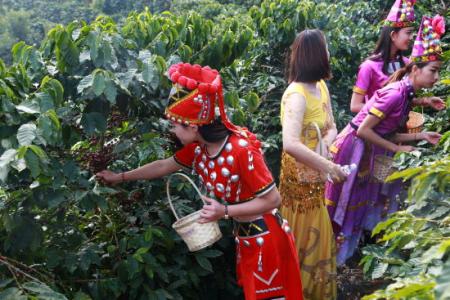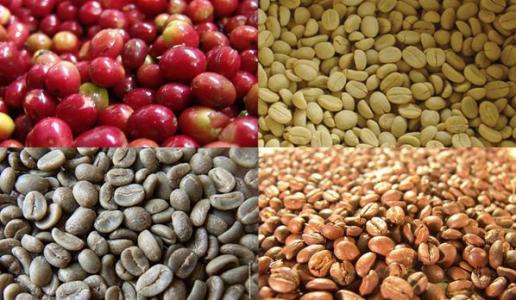Description of taste and flavor of Katim coffee beans introduction of varieties produced by grinding scale treatment
Description of taste and flavor of Katim coffee beans introduction of varieties produced by grinding scale treatment
Many chopped beans, adzuki beans and bad beans still have a lot of defective beans after drying, so we hand-picked them on the spot and finally left 9 kilograms of qualified ones-- and most of the morning has passed, of course, if it is used to make instant coffee or general commercial beans, high-yield catimor is a good choice, but we want to find Yunnan specialty coffee. Then the old variety of iron pickup has become the first choice because of its congenital excellent gene. Therefore, this trip to Yunnan also followed the trail of the old varieties. But the reality is really cruel. Before going, Brother Zou told me that there was an old variety in his relative's house, but what he saw excitedly was a wild growing coffee forest, which belonged to his aunt. Because his aunt was too old and did not have the strength to replant and renovate-- these old varieties survived, but the aunt was unable to manage it alone, so the tree was allowed to grow naturally. When ripe to pick some fruit, the so-called new variety actually refers to catimor (Katimo), which is a hybrid of the timor species of the Roberta family and Arabica. Compared with the old variety, it lacks rich aroma and flavor, and has a relatively shallow smell of grass and soil, but it has the advantages of resistance to diseases and insect pests, easy management and high yield, and its yield per mu is up to 350kg, which is more than twice that of the old variety.
So when Nestl é succeeded in promoting high-yield new varieties in Pu'er in the 1990s, brown farmers in Baoshan also cut down old varieties and changed them to new ones. With a round of coffee expansion, new varieties are increasing and old varieties are decreasing day by day. Finally, today's situation: the old varieties have almost been cut down, and the little ones that survived are all "old, weak, sick and disabled". Most of the trees are more than 20 years old. Out of control over time, the output and quality are much lower than before.
Arabica and Robusta are species of coffee trees. The former grows at high elevations, while the latter grows at low elevations. They are so different in use that there are few occasions where they can be compared. However, Hainan and Yunnan are different in producing areas, and their taste and flavor will be slightly different due to the influence of local soil, water and climate. As for the specific differences, I personally feel that the differences in the degree of baking have masked the differences between the two producing areas of raw beans.

Important Notice :
前街咖啡 FrontStreet Coffee has moved to new addredd:
FrontStreet Coffee Address: 315,Donghua East Road,GuangZhou
Tel:020 38364473
- Prev

Flavor Description of Brazilian Yellow Bourbon Coffee Bean Grind Scale Processing Taste Introduction of Producing Region
Bourbon species, native to the Indian Ocean island of Bourbon (now known as Reunion Island), is the iron pickup (Typica) mutation produced by the second species, and iron pickup belongs to the oldest existing coffee varieties, green fruit will appear bright red when ripe, and yellow Bourbon species is Bourbon species and other varieties hybrid. Because of its production
- Next

Description of Flavor of Red Cherry Sunshine Sidama Coffee beans introduction of varieties produced by Grinding Calibration method
Red Cherry Sunshine Sidama Coffee beans Flavor description Grinding scale processing Regional Variety introduction Red Cherry Project (Operation Cherry Red) is a small-scale farm quality improvement project since 2005, led by the Dutch trading company Trabocca BV and partly funded by the Dutch government. This is enhanced by providing the expertise of producers and the assistance of related technologies.
Related
- Detailed explanation of Jadeite planting Land in Panamanian Jadeite Manor introduction to the grading system of Jadeite competitive bidding, Red bid, Green bid and Rose Summer
- Story of Coffee planting in Brenka region of Costa Rica Stonehenge Manor anaerobic heavy honey treatment of flavor mouth
- What's on the barrel of Blue Mountain Coffee beans?
- Can American coffee also pull flowers? How to use hot American style to pull out a good-looking pattern?
- Can you make a cold extract with coffee beans? What is the right proportion for cold-extracted coffee formula?
- Indonesian PWN Gold Mandrine Coffee Origin Features Flavor How to Chong? Mandolin coffee is American.
- A brief introduction to the flavor characteristics of Brazilian yellow bourbon coffee beans
- What is the effect of different water quality on the flavor of cold-extracted coffee? What kind of water is best for brewing coffee?
- Why do you think of Rose Summer whenever you mention Panamanian coffee?
- Introduction to the characteristics of authentic blue mountain coffee bean producing areas? What is the CIB Coffee Authority in Jamaica?

